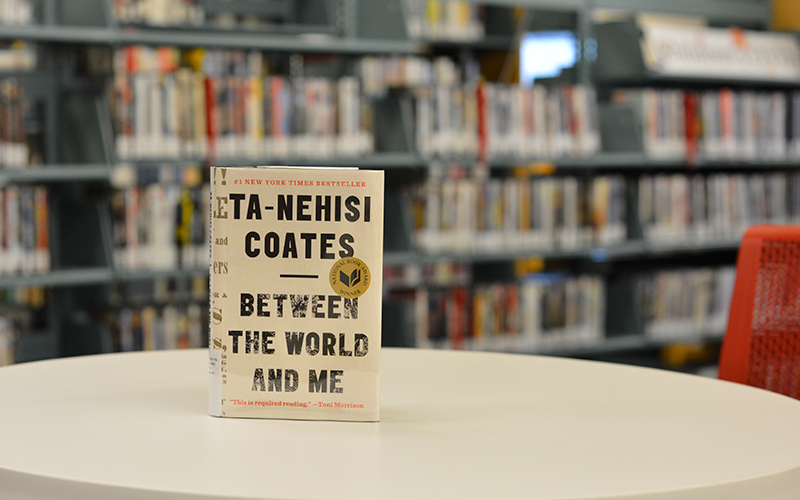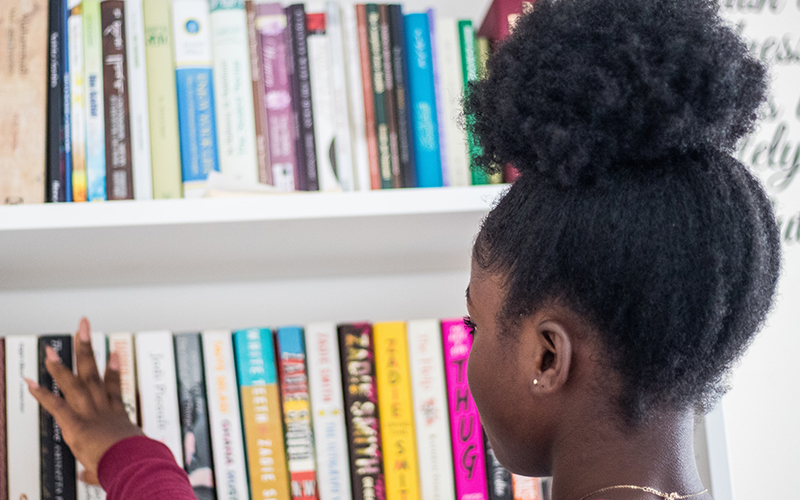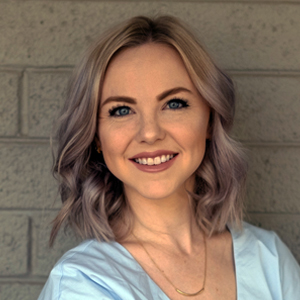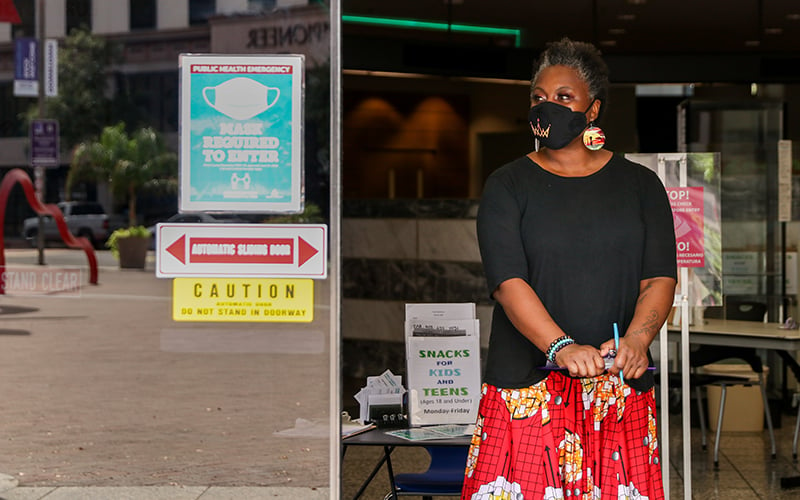
The Arizona State University library system’s goal is to build a Black Lives Matter resource guide – an online collection of books, podcast episodes, academic courses, data on police violence and more. (Photo by Allie Barton/Cronkite News)

In “Between the World and Me,” Ta-Nehisi Coates writes as a Black American to his son. It’s among the books included in Arizona State University’s Black Live Matters online resources guide. (Photo by CCAC North Library/Creative Commons)
PHOENIX – During months of public demonstrations spurred by the death of George Floyd last spring and centuries of injustices against Black lives across the globe, Arizona State University Libraries created a digital resource guide focused on the Black Lives Matter movement, justice and equity.
The elements of the Black Lives Matter guide extend beyond those of a typical book list. The online collection of literature, podcast episodes, academic courses, police violence data, and archival information, built on the tumult of 2020, is continuously evolving. It’s a chronicle of a year plagued by historic milestones, including a global pandemic, brutality toward the Black community and a polarizing election that continues to shift societal norms.
People can explore the guide’s trove of treasures, which features links to podcasts such as “Hella Black, described as “all things related to Blackness;” how-to’s on antiracism; and books, including “The Color of Law,” which elucidate government policies that segregate opportunity. The guide also features such courses and talks as Yale University’s recorded course “African American History: From Emancipation to the Present;” a map of BLM protests; local media coverage of the protests; resources for K-12 learners; and self-care help.
“It has helped us gather new materials, and it has made us take a look at all of our guides to make sure we’re inclusive in the contributions of people of color,” said Deborah Abston, a liaison librarian in the Social Sciences Division of the Engagement & Learning Services Directive at ASU.
Abston is one of seven staff members who curated the online collection. She has contributed to several of the university’s topical digital guides in her 30 years at the library, with the recent BLM guide gaining momentum, she said.
Abston discussed the inspiration, creation and impact of the guide with Cronkite News. Her answers have been lightly edited and condensed.

The public can search the Black Lives Matter digital guide, curated by the Arizona State University library system. The online collection offers a trove of literature, podcast episodes, academic courses, data on police violence and archival information. (Photo by Suad Kamardee/Unsplash)
What is the ASU Library Black Lives Matter guide?
It was created for anyone and everyone to use to find resources on Black Lives Matter. We want it to provide information on the history, the currency, and it doesn’t include everything but it includes things that could lead people to other things. We wanted to give people something to get started with. It’s for anyone in our community that needs information, and we tried to make sure that we could make that information available, not just at ASU but in many other places.
What inspired the creation of the guide?
We like to create displays of materials that we have, we do it for Black History Month, for Women’s History Month, for Banned Books week, and things like that. But after the killing of George Floyd, we were inspired to do more because it ignited the country. And we wanted people to be able to easily find resources on the topic of Black Lives Matter, justice and equality in the world.
Has the guide helped the ASU Library reach outside ASU?
Yes, and that was one of our main ideas, to go beyond ASU to reach our community or different communities. ASU serves more than just the traditional university student and faculty. It’s a big organization and our community is the world. So we wanted to be sure that we included things for everyone. We had to think beyond ourselves and beyond our disciplines because more people are asking about the guide, and you can’t be all things to all people, but we wanted to be out there for as many people as we could be. We used information that was not just available at ASU, but information available in other places, and that’s how it got to be so big so quickly. But we’re constantly adding to it – it’s kind of our baby.
How long did it take you to curate the guide?
We started it around April, but we keep refining it and adding to it because there’s always more information being uncovered – history is like that. We’re always discovering new things and things we already have and new information that we think is new has always been there. This guide is a living thing that we keep adding to and feeding. We work on it a little at a time, all the time, and it’s been fun to do.
How did you choose which resources to include?
We wanted to include everything anybody sent us but we couldn’t. We tried to use the same kinds of criteria that we use when we’re acquiring materials for the library. Who was the creator of this object? What authority do they have? How do they know what they know? What sources did they use to curate this information? Curating this list worked the same way. We didn’t want to rush, we wanted it to look professional and we wanted people to know that we knew what we were doing. We weren’t just pulling together a bunch of information.
Did you take submissions from the public?
Most of the suggestions we got were from other librarians or requests from faculty members or sent to us by a teacher or students. Anyone could send us something, and once people knew we were working on it, we kept getting sent things. We were sent something just today, that we will probably add. It’s always exciting to find something new, but we also wanted to highlight things we already had. We have millions of collections in our library and we have lots of information that just wasn’t highlighted. We automatically buy things, but we wanted to highlight what was already there in addition to the new things, and that’s why we have such a variety of resources. They came from everywhere.
What else makes this guide so meaningful?
We want to have all of this information, but it’s also sad that we have to have it – in this day and age when you think things are better but they’re really not as great as you thought they were. This information is kept out there so that all people can learn from it so that maybe the necessity for guides like this could be less urgent. We felt the sense of urgency when we created it and it’s still there. I don’t know if that sense of urgency will ever go away. But you feel it when you create something like this because you feel passionately about it and you want people to know. This group of librarians got together to make sure that people were informed. That’s what we wanted.


